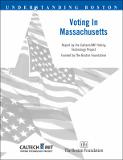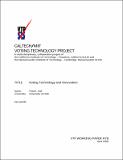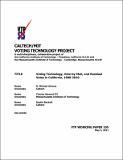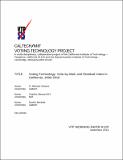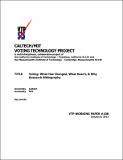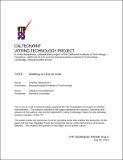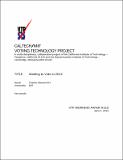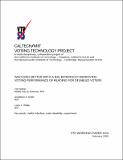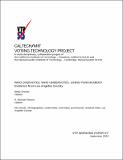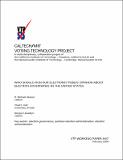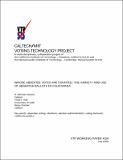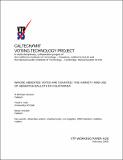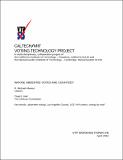Browsing Publications and Working Papers by Title
Now showing items 104-123 of 123
-
Voting in Massachussetts
(Massachussets Institute of Technology, 2003) -
Voting Technology and Innovation
(Caltech/MIT Voting Technology Project, 2009-04)The 2008 election was different from the last two presidential elections in that there was a clear winner on Election Day and the winner was a Democrat, Barack Obama. Controversies over voting technology that raged in 2000 ... -
Voting Technology and the Election Experience: The 2009 Gubernatorial Races in New Jersey and Virginia
(Caltech/MIT Voting Technology Project, 2010-07-14)In this paper, we examine the attitudes of voters regarding the voting experience in the 2009 gubernatorial elections in New Jersey and Virginia. We focus especially on the way in which voting technology experiences that ... -
"Voting Technology and Uncounted Votes in the United States"
(Journal of Politics, 2004-08) -
Voting Technology Summary and Report Working Papers
(2004-08-20) -
Voting Technology, Vote-by-Mail, and Residual Votes in California, 1990-2010
(Caltech/MIT Voting Technology Project, 2011-05-05)This paper examines how the growth in vote-by-mail and changes in voting technologies led to changes in the residual vote rate in California from 1990 to 2010. We find that in California’s presidential elections, counties ... -
Voting Technology: Vote-by-Mail, and Residual Votes in California, 1990-2010
(Caltech/MIT Voting Technology Project, 2013-09)To test the supposition that the lost votes recovered by California through the modernization of voting technologies may be being undone by the trend toward more voting by mail, Table A1 attempts to quantify changes in the ... -
Voting: What Has Changed, What Hasn't, & Why: Research Bibliography
(Caltech/MIT Voting Technology Project, 2013-01-08)Since the origins of the Caltech/MIT Voting Technology Project in the fall of 2000, there has been an explosion of research and analysis on election administration and voting technology. As we worked throughout 2012 on ... -
Waiting in Line to Vote
(Caltech/MIT Voting Technology Project, 2013-07-28)Waiting in line to vote is the most visible sign of the administrative friction of managing elections. The visibility of long lines makes them a convenient symbol for those who seek to improve election administration. ... -
Waiting to Vote in 2012
(Caltech/MIT Voting Technology Project, 2013-04-01)Waiting in line to vote is one of the clichés of Election Day, whether the venue is Kenya or the United States. The length of time waiting to vote has regularly been an issue in the voting wars of the past decade. Long ... -
What Hath HAVA Wrought? Consequences, Intended and Not, of the Post-Bush v. Gore Reforms
(Caltech/MIT Voting Technology Project, 2011-04-07)The Help America Vote Act (HAVA)1 is the most important direct federal response to the 2000 electoral fiasco in Florida. HAVA had many provisions, some directly inspired by the controversy, others that came along for the ... -
Where the Good Signatures Are: The Number and Validity Rates of Initiative Petition Signatures Gathered in California Counties
(Caltech/MIT Voting Technology Project, 2004-01-23)One of the biggest hurdles to qualifying an initiative for the ballot is gathering the required number of signatures. Yet little is known about these signatures' representativeness or demographic origin. Using data from ... -
Who Does Better with a Big Interface? Improving Voting Performance of Reading for Disabled Voters
(Caltech/MIT Voting Technology Project, 2005-02)This study shows how ballot interfaces variably affect the voting performance of people with different abilities. An interface with all information viewable simultaneously might either help orient or overwhelm a voter, ... -
Who Overvotes, Who Undervotes, Using Punchcards? Evidence from Los Angeles County
(Caltech/MIT Voting Technology Project, 2003-09-09)In this study we examine over- and undervotes from the November 2000 General Election in Los Angeles County. Los Angeles County is the nation's largest election jurisdiction and it used a punchcard voting system in that ... -
Who Should Run Our Elections? Public Opinion About Election Governance in the United States
(Caltech/MIT Voting Technology Project, 2006-02)Much has been said since the 2000 presidential election regarding the administration of elections in the United States, particularly in regards to how election administrators are selected and to whom they are responsive. ... -
Whose Absentee Votes Are Counted: The Variety and Use of Absentee Ballots in California
(Caltech/MIT Voting Technology Project, 2005-07-19)Absentee voting is becoming more prevalent throughout the United States. While there has been some research focused on who votes by absentee ballot, little research has considered another important question about absentee ... -
Whose Absentee Votes Are Counted?
(Caltech/MIT Voting Technology Project, 2005-02-01)Absentee voting is becoming more prevalent throughout the United States. While there has been some research focused on who votes by absentee ballot, little research has considered another important question about absentee ... -
Whose Absentee Votes Are Counted?
(Caltech/MIT Voting Technology Project, 2004-04)Absentee voting is becoming more prevalent throughout the United States. While there has been some research focused on who votes by absentee ballot, little research has considered another important question about absentee ... -
Why Everything That Can Go Wrong Often Does: An Analysis of Election Administration Problems
(Caltech/MIT Voting Technology Project, 2003-11-26)Before the 2000 presidential election, few citizens in the United States paid much attention to election administration. But scholars have noted that election administration has been a problem for decades. Despite the ... -
Written Testimony of Charles Stewart III Before the U.S. Senate Committee on Rules and Administration
(Caltech/MIT Voting Technology Project, 2014-05-14)THERE IS A NEED FOR A MORE DATA-CENTERED APPROACH TO ELECTION ADMINISTRATION. Election policymaking would greatly benefit from metrics-based policymaking, and the development of measures similar to those in policy areas ...
